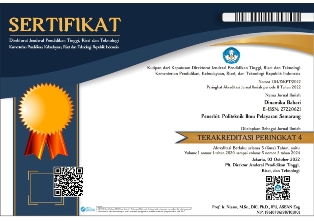Evaluasi Keselamatan Kerja Listrik Laboratorium Permesinan Kapal Universitas Maritim AMNI Semarang Dengan Metode Analitycal Network Process (ANP)
Abstract
In the operation of electrical components in the ship engineering laboratory of the Maritime University of AMNI Semarang, various kinds of protection are needed. Errors in installing and operating electrical equipment can reduce protection. This protection aims to improve the safety of electrical work in ship engineering laboratories. And in the application of electrical work safety, it is necessary to evaluate based on the 2000 Electrical Installation General Requirements standard (PUILL 2000). The purpose of this study was to evaluate the use of the laboratory of the Maritime University of AMNI Semarang in the aspect of work safety. Based on the results of the evaluation, the criteria for electrical work safety are determined, namely: protection for safety, protection from overvoltages and currents, protection from thermal effects, and protection from fault currents. After the evaluation was carried out, alternatives were found to improve electrical safety: standard operating procedure (SOP), an inspection of cable installations, checking MCB panels and switches. The criteria and alternatives obtained then processed using the software super decision ver.2.10.0 with the Analytical Network Process (ANP) method so that the priority results of electrical safety improvements in the ship engineering laboratory of AMNI Maritime University Semarang are: repair of SOP 63.7%, cable installation 25.8%, MCB panel, and 10.5% switch.
Downloads
References
Faulconer, E., Faulconer, L., & Hanamean, J. (2019). Arriving at a Better Answer: A Decision Matrix for Science Lab Course Format. Journal of College Science Teaching, 48(4), 31-35.
Ghosh, M. C., Basak, R., Ghosh, A., Balow, W., & Dey, A. (2015). An Article on Electrical Safety. International Journal for Scientific Research & Development, Vol. 3(10), 503-506.
Gille, J., Schmidt, T., Dragu, A., Emich, D., Hilbert-Carius, P., Kremer, T., et al. (2018). Electrical injury – a dual center analysis of patient characteristics, therapeutic specifics and outcome predictors. Scand J Trauma Resusc Emerg Med 26, 43.
Heradio, R., de la Torre, L., Galan, D., Cabrerizo, F., Herrera-Viedma, E., & Dormido, S. (2016). Virtual and remote labs in education: A bibliometric analysis. Computers & Education, 98, 14-38.
Ismara, Ima, K., & Prianto, E. (2016). Keselamatan dan kesehatan kerja di bidang kelistrikan (electric safety). Solo: Adicandra Media Grafika.
Kertiasih, & Putu, N. L. (2016). Peranan Laboratorium Pendidikan untuk Menunjang Proses Perkuliahan Jurusan Keperawatan Gigi Poltekkes Denpasar. Jurnal Kesehatan Gigi (Dental Health Journal), 4(2), 59-66.
Kolil, V. K., Muthupalani, S., & Achuthan, K. (2020). Virtual experimental platforms in chemistry laboratory education and its impact on experimental self-efficacy. Int J Educ Technol High Educ, 17 (30).
Lasica, I., Katzis, K., Meletiou-Mavrotheris, M., & Dimopoulos, C. (2016). Research challenges in future laboratory-based stem education. Bulletin of the IEEE Technical Committee on Learning Technology, 18(1).
McLaughlin, J., Favre, D., Weinstein, S., & Goedhart, C. (2017). The Impact of a Four-Step Laboratory Pedagogical Framework on Biology Students' Perceptions of Laboratory Skills, Knowledge, and Interest in Research. Journal of College Science Teaching, 47(1), 83-91.
Miller, T., Carver, J., & Roy, A. (2018). To Go Virtual or Not to Go Virtual, That is the Question: A Comparative Study of Face-To-Face Versus Virtual Laboratories in a Physical Science Course. Journal of College Science Teaching, 48(2), 59-67.
Persyaratan Umum Instalasi Listrik. (2000). Jakarta: Badan Standarisasi Nasional PUIL 2000.
Reece, A., & Butler, M. (2017). Virtually the Same: A Comparison of STEM Students' Content Knowledge, Course Performance, and Motivation to Learn in Virtual and Face-to-Face Introductory Biology Laboratories. Journal of College Science Teaching, 46(3), 83-89.
Saaty, T., & Vargas, L. (2006). Decision making with the analytic network process, Economic, Political, Social and Technological Applications with Benefits, Opportunities, Costs and Risks. Pittsburgh, USA: University of Pittsburgh.
Wong, F. K., Chan, A. P., Wong, A. K., Hon, C. K., & Choi, T. N. (2018). Accidents of Electrical and Mechanical Works for Public Sector Projects in Hong Kong. International Journal of Environmental Research and Public Health, 15 (3).














